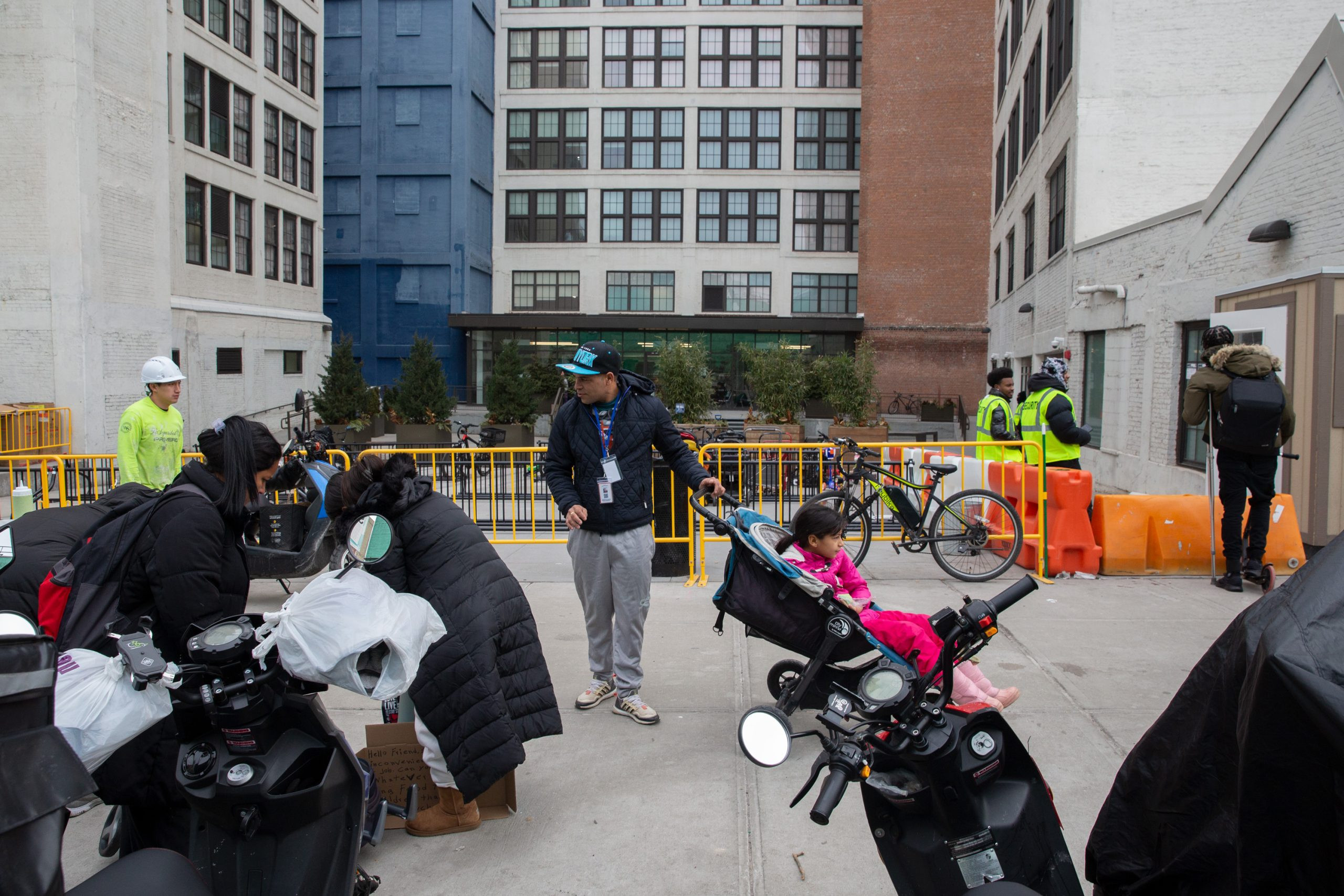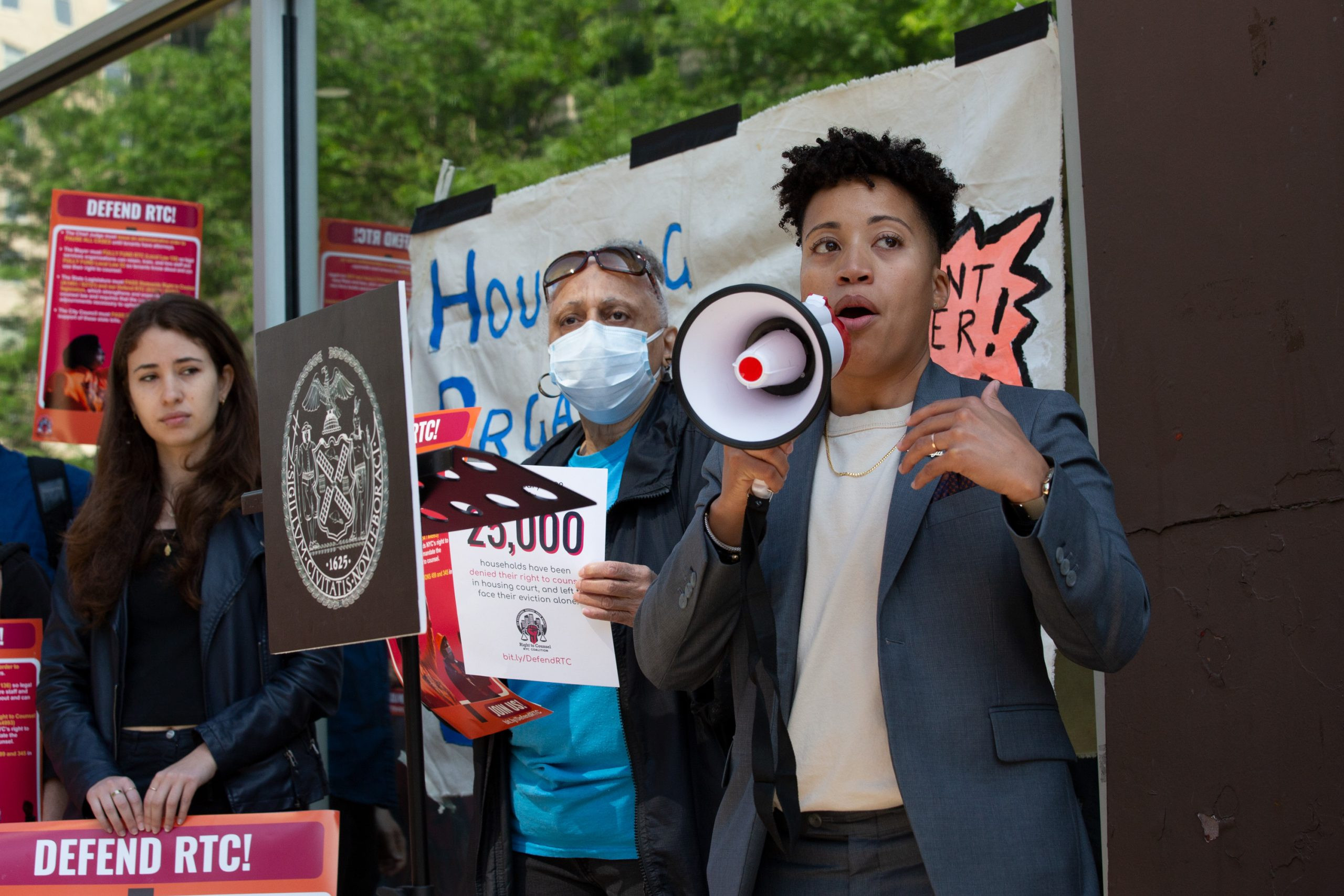A once-quiet street in Brooklyn’s Clinton Hill, Hall Street, has undergone a dramatic transformation with the silent expansion of a massive migrant shelter complex. Since its inconspicuous opening last summer in converted warehouses, this facility has grown to house approximately 3,000 individuals seeking refuge. Operated by the city’s Health + Hospitals, the complex, situated near the Brooklyn Navy Yard, has the potential to accommodate up to 6,000 people with additional buildings on the same block and another warehouse across Hall Street under the Department of Homeless Services, capable of housing hundreds more migrant families.
This substantial growth of the Hall Street shelter has reverberated through the neighboring residential areas, sending shockwaves and sparking a mix of reactions within the community. Local schools have experienced a sudden influx of new students, met with an inspiring wave of community support. Simultaneously, community board meetings have become forums for residents to voice concerns about the escalating trash, increased noise levels, and issues of loitering. Similar to other neighborhoods across New York City, the arrival of migrants has tested the social fabric of Clinton Hill, creating divisions and compelling neighbors to confront the challenges and complexities of this evolving situation on Hall Street.
While many of the shelter residents face short stays of 30 to 60 days, the sheer scale of the Hall Street shelter suggests a longer-term presence, potentially for up to eight years, based on the city’s contract with property owner RXR Realty. This extended duration implies a lasting change for the area, altering the character of what was once a low-traffic block into a bustling thoroughfare reminiscent of Midtown Manhattan. This shift is so pronounced it’s even reflected on Google Maps, where the location is now informally labeled “Brooklyn chester,” a phonetic interpretation of “shelter” in Spanish, highlighting the profound impact on the local perception of Hall Street.
“Hall Street was a no man’s land. It’s a dead end street. [Now] it’s like Grand Central Station,” observed Monique Gramby, a 55-year-old resident of Hall Street for two decades, encapsulating the neighborhood’s dramatic shift.
“We’re understanding and sympathetic to the migrants’ plight, but at the same time, you’re really impacting our way of life,” she added, voicing a sentiment shared by many long-term residents grappling with the changes on Hall Street.
‘Massive Unmet Need’ Emerges Around Hall Street Shelter
Initially housing only adult migrants when it opened last July, the Hall Street shelter experienced a significant shift in late December. City officials expanded operations, converting more industrial spaces into partitioned cubicles to accommodate hundreds of families. This transformation established the Hall Street location as the city’s second large-scale quasi-dormitory facility for migrant parents and children.
The impact on local schools became immediately apparent after the holiday break in January. PS/IS 157 in Bedford-Stuyvesant, located near Hall Street, saw a surge of newly enrolled migrant children, quickly adding over 100 students to its rolls within days. This influx nearly restored the school’s student population to pre-pandemic levels, reversing years of declining enrollment due to gentrification and the pandemic. Principal Kourtney Boyd expressed enthusiasm about the new students, stating, “If we don’t have kids running through our building, learning in our building, we have no purpose. It feels like we’re doing the work that we were chosen to do.”
 Migrant families leave the Hall Street shelter in the morning.
Migrant families leave the Hall Street shelter in the morning.
The school community quickly recognized the urgent needs of the new families. Parents and teachers initiated donation drives, emptying their own closets and appealing to the wider community for essential items like winter clothing. Sara Nordmann, a parent at the school, recounted, “People in the broader neighborhood were seeing families digging in the trash on snowy days, desperately looking for food and items. The whole community was seeing a massive unmet need.”
The response was overwhelming, with donations flooding in, including a significant anonymous donation of brand-new winter jackets. Edwin Martinez, a school custodian and aide, described the community’s generosity as inspiring. However, the 60-day eviction notices issued to many families at the Hall Street shelter cast uncertainty over the long-term stability for these newly enrolled students. Andreina Zambrano, a Venezuelan mother with children at PS/IS 157, shared her family’s impending shelter eviction and the precarious situation many families face, highlighting the temporary nature of their housing on Hall Street and the broader uncertainty.
Rising Tensions and Community Concerns Near Hall Street
Beyond the immediate embrace from the school community, tensions have arisen among some residents living near the Hall Street shelter. Complaints range from increased trash and noise to loitering and disputes with shelter staff. Councilmember Crystal Hudson’s office has become a focal point for these grievances. Initially, some complaints exhibited xenophobic undertones, but more recently, practical concerns about sanitation and disturbances have become more prominent.
 Councilmember Crystal Hudson (D-Brooklyn) spoke outside Brooklyn Housing Court about a lack of access to lawyers for tenants, May 31, 2023.
Councilmember Crystal Hudson (D-Brooklyn) spoke outside Brooklyn Housing Court about a lack of access to lawyers for tenants, May 31, 2023.
Hudson acknowledged the increase in street homelessness in the vicinity, partly attributed to shelter residents being evicted or exceeding their stay limits. Despite raising these issues with city administration, Hudson expressed feeling unsupported, stating, “We’ve shared all of our concerns and the concerns of our constituents with the administration and are left sort of to fend for ourselves.”
These frustrations culminated at a community board meeting where residents directly confronted Health + Hospitals representatives. Adam Simon, a long-time Hall Street resident, voiced the sentiment that “It’s too many people in one community,” emphasizing the unprecedented scale of the shelter’s impact. Karen Marshall Hicks, another Hall Street resident, recounted personal incidents of theft and confrontation, illustrating the heightened anxieties within the neighborhood.
 Clinton Hill residents expressed concerns about a large-scale migrant shelter at a Community Board 2 meeting in Downtown Brooklyn.
Clinton Hill residents expressed concerns about a large-scale migrant shelter at a Community Board 2 meeting in Downtown Brooklyn.
Laura Atlas from Health + Hospitals defended the shelter’s size by contextualizing it within the broader migrant crisis, emphasizing the urgency to provide shelter for thousands arriving daily. In response to community concerns, Health + Hospitals committed to regular meetings with residents and established a communication channel for addressing issues, aiming to improve dialogue and responsiveness regarding the Hall Street shelter’s integration into the community.
Life Inside the Hall Street Shelter: Challenges and Gratitude
Inside the Hall Street shelter, conditions present daily challenges for residents. Families and individuals reside in cubicles, sharing communal facilities. Complaints about food quality and restrictive rules, such as early nightly light shutdowns, are common. Cristofer Hernandez, a Venezuelan father residing at the shelter with his family, described the lack of rest due to noise and strict routines, yet expressed gratitude for having shelter. “We give thanks we have a roof over our heads here,” he acknowledged, reflecting the complex mix of hardship and relief experienced by many within the Hall Street facility.
Lemine, a migrant from Mauritania, described a feeling of confinement and exhaustion, compounded by the inability to work and challenging living conditions. Despite these difficulties, the shelter provides a critical, albeit basic, necessity for thousands navigating the complexities of seeking asylum in New York City.
Hall Street: A ‘Humanitarian Corridor’ and a Neighborhood Divided
Hall Street has become a focal point of community discourse, embodying both compassion and conflict. While some residents contemplate leaving due to the changes, others actively engage in providing aid and advocating for better city services to support both shelter residents and the existing community. The street now functions as a “humanitarian corridor,” as described by neighbor Kevin Ley, marked by a constant flow of people seeking assistance and navigating new realities.
Long-term Hall Street resident Ragnar Naess offered a broader perspective, emphasizing the relative insignificance of minor inconveniences compared to the profound hardships faced by migrants. He highlighted the need for empathy and understanding, urging neighbors to consider the larger humanitarian context of the situation unfolding on Hall Street and within their community.
